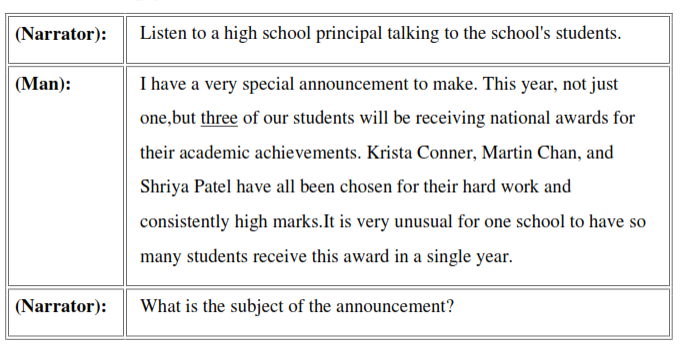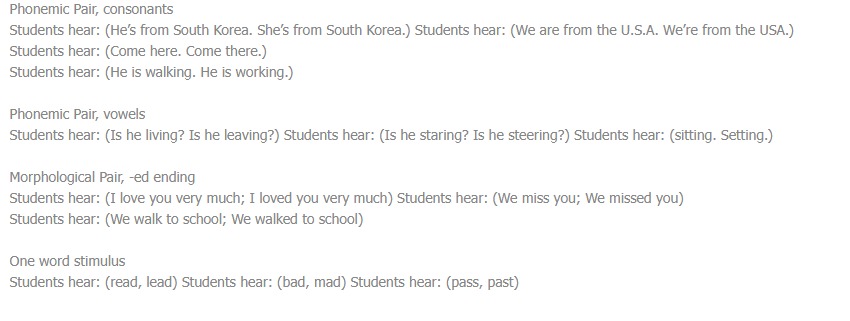Tenrycolle.com
What better to do than, share your English knowledge with other people
What better to do than, share your English knowledge with other people
What better to do than, share your English knowledge with other people

Brown states that listening comprehension assessment involves two main aspects: language aspects (micro skill) and content understanding (macro skill).
Micro skills can be formulated in the following items:
Macro skills can be formulated in the following items:
Read also: Definition and Stages of Listening Process
It is first developed at a very early age. This task is the most basic form of listening and does not involve understanding the meaning of words or phrases but merely the different sounds produced.
So, discriminative listening is the basic listening task directed towards the source of the sound.
Example: Difference sounds are identified
Comprehensive listening (also known as content listening, informative listening and full listening) builds on discriminative listening. It involves comprehending the speaker’s message based on different features such as vocabulary, language skills, perception, and nonverbal cues.
If you are getting directions, watching the news, or listening to a lecture, you are listening to understand or comprehend the message being sent.
For example
On the recording, you will hear:

In your test book, you will read:
1. What is the subject of the announcement?
a. The school will be adding new classes.
b. Three new teachers will be working at the school.
c. Some students have received an award.
Intensive listening assessments test the student’s ability to recognize phonemes, morphemes, words and different derivatives thereof, as well as discourse markers and intonation (Brown, 2010). Students must listen carefully for components in a large stretch of languages, such as phonemes, intonation, and discourse markers.
These assessments are great for assessing students with past-tense markers and stressed and unstressed parts of words.
This form of listening assessment assesses students’ ability to correctly identify different phonemes and morphemes commonly found in the English language

(Adapted from McKenna & Stahl, 2009, An Adaptation of Hearing Sounds in Words)
Teacher: “I’m going to read you a story two times. The first time, I want you to listen. The second time, I will read slowly and I want you to write down the words as best you can. Do you understand?”
If the student answers no, explain it again in a different way.
Scoring: If the phoneme is represented, it is counted in the scoring. Each phoneme is a point. Spelling does not have to be correct as long as the phoneme is represented.

Responsive listening is another task used in listening assessments. It can be assessed in more than one manner. It allows the students to actively participate and produce the language through speaking or writing in response to spoken stimulus (Brown, 2010).
A less practical manner but possibly more authentic (depending on the format of the question) is open-ended response questions.
Students will be asked a question such as “How much time did it take to do your homework” and test-takers will write or speak their response.
This format encourages full, meaningful answers that the individual knows or feels. These question reflects the test-takers knowledge and requires the skills of listening and speaking (also writing if applicable).
You will hear a series of questions. After each one, you will be given time to write down an answer to the question.
This type of assessment focuses on the student’s ability to understand what is being said by responding to a question that has been asked.
Students hear: (Can you help me, please?)
Students respond or choose from 4 choices. The correct one must be verbally given: (yes, I can.)
The fifth aspect of listening is selective listening. It is when a student listens to a piece of information and must discern specific information.
There are several activities for this task, such as:
A Listening Cloze task is a popular assessment that requires the student to listen to a story, monologue, or conversation. Listening cloze tasks may focus on grammatical categories such as verb tenses, articles, prepositions, etc.
Students see a transcript of the passage they are listening to and must fill in the missing information (deleted words or phrases). Students must filter out irrelevant information and retain the relevant information.
Students hear a dialogue and input the missing keywords:
Minsu: What time is it, mom?
Minsu’s mom: It is ________________.
Minsu: What _____________ is it?
Minsu’s mom: It’s eight.
Minsu’s mom: Oh, no. It’s ______________.
Minsu: Nine. _________?
Minsu: Oh __________! I am late!
Information transfer is a technique that presents aural information and must be transferred to a visual representation such as a chart or diagram.
Students may have to identify an element in a picture, fill out a calendar/ planner, or show routes on a map.
This assessment requires the student to actively listen, filter relevant information, and write the information where appropriate.
This assessment forces students to listen carefully to details while writing them down on a chart; it creates an authentic environment where students can learn English practically.
Example:

Extensive listening tasks focus on macro-skills of listening, such as inferring situations, goals, and participants based on real-world knowledge, distinguishing between implied and literal meanings, and using a variety of listening strategies such as detecting keywords and using context to guess the meaning of a word (Brown, 2010).
These tasks are used for advanced English Language Learners. Extensive listening tasks include lectures, long conversations, and lengthy messages that require listeners to decipher information and derive meaning.
There are several activities for this task, such as:
Dictation provides a reasonable method of integrating listening and writing skills implied in short passages. However, depending on passage length, this method places more strain on memory and the process of meaning.
Students take this test to listen to a passage about 50 to 100 words in length three times (normal speed/ slow speed/ then normal again). Then, students write down what they heard, which requires good listening and writing skills.
This form of listening assessment assesses students’ ability to identify phonemic differences within a normal conversation.
Students are writing while the instructor reads a passage.
First, read at normal speed (students only listen). I can skate. I can ski. Can you swim? Yes, I can. Help! Help! Wait! I’m coming.
Second read with designated pauses (students write): (I can/skate. I can/ski. Can you swim? Yes,/ I can. Help! Help! Wait! I’m coming.)
Third, read at normal speed (students check their work): I can skate. I can ski. Can you swim? Yes, I can. Help! Help! Wait! I’m coming.
An authentic example of extensive listening is “Dialogue and multiple-choice comprehension items”. The test-taker listens to a monologue or conversation and then is asked to answer a set of comprehension questions.
Passages for this assessment can be created or altered with creativity and authenticity to make the assessment more meaningful. This assessment allows students to gather information and apply it in their responses. This assessment is used for advanced English language learners.
This assessment test students’ ability to gather the information they just listened to and apply it in answering questions.
(Students hear) Okay, students, it is time to go outside. Please put on your mittens or gloves and your sweaters. You do not want to be cold as we will be outside for some time. Does anyone have any questions? Alright, let’s go!
1. What is the weather like outside?
A. hot
B. rainy
C. cold
D. cloudy